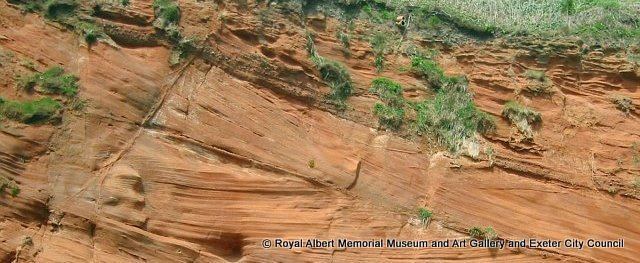Region Global Primary Sandstone | Country United Kingdom | |
 | ||
Other Arkose, conglomerate, Breccio-Conglomerate | ||
The New Red Sandstone is a chiefly British geological term for the beds of red sandstone and associated rocks laid down throughout the Permian (280 million years ago) to the end of the Triassic (about 200 million years ago) that underlie the Jurassic Lias; the term distinguishes it from the Old Red Sandstone which is largely Devonian in age.
Contents
Its upper layers consist of mudstones, but most of the formation consists of reddish sandstones, interbedded with rare evaporite minerals such as halite and gypsum; these indicate deposition within a hot and arid palaeo-environment e.g. a desert or sabkha.
Central UK locations
The New Red Sandstone covers much of central England, where it generally forms a low-lying plain except for the Mid Severn Sandstone Plateau. Thick layers (up to 1100 m thick) are present in the faulted Cheshire Basin which also extends beneath north Shropshire. There are numerous escarpments forming small prominent hills within this area. The sandstone also underlies parts of Lancashire and Cumbria, and east of the Pennines it extends through Nottinghamshire and central Yorkshire. Smaller outcrops occur in other parts of Britain such as the Red Cliffs of Dawlish and East Devon.
Lithology
In terms of its lithology, the New Red Sandstone comprises true sandstones, mudrocks and evaporite strata. The sandstone units are monomineralic, consisting only of quartz grains (negligible amounts of other minerals may be present), and they are cemented together with the ferric iron oxide haematite (Fe2O3). The presence of this particular iron oxide is evidence for a terrestrial environment of deposition such as a desert, and gives the rocks the red colour which they are named after. The common effect of rusting produces exactly the same deposit, but as a result of a different process. The sandstone units generally lack fossils (as do most terrestrial rocks). The grains in the member have a high degree of sphericity, are very well sorted and typically have a small size range (0.5 mm to 2 mm).
The NRS is a texturally mature rock. Certain units of the New Red Sandstone (e.g. Helsby Sandstone Formation) feature commonly as building stone in the Cheshire area due to their abundance and mechanical strength.
Building Uses
Many ancient buildings of Devon Red Sandstone can be found in Exeter the ancient capital of Devon, notably the Castle, Roman / Medieval city walls, several churches and many buildings of the Cathedral Close. The local quarry was at Heavitree by which name the local sandstone - actually a type of breccia - is generally known.
